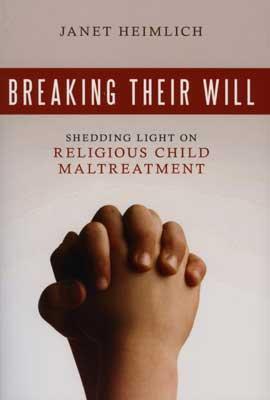Catholic Sentinel
November 8, 2011
http://www.catholicsentinel.org/Main.asp?SectionID=6&SubSectionID=31&ArticleID=16665
 |
"Breaking Their Will: Shedding Light on Religious Child Maltreatment," by Janet Heimlich. Prometheus Books (Amherst, N.Y., 2011). 397 pp., $20.
Any book detailing child abuse by religious authorities or in the name of religion is a hard read for people of faith. Believers are faced with a harsh reality: Many of their cherished values and concepts have been manipulated, distorted or misunderstood for perverse or violent ends.
"Breaking Their Will" is no different. It narrates stark cases of children who were abused sexually, physically, emotionally and through medical neglect, all in the name of religion. For Catholics — after a decade of reading about clergy child sex abuse in the United States and Europe — learning that abuse goes beyond the confines of their church and is not limited to sexual maltreatment doesn't lessen the blow.
Author Janet Heimlich shows that sexual and other abuses of children in the United States are present in Judaism, Islam and various Christian churches. As the book title states, the primary goal of abusive adults is to break the will of children, using religion or their moral authority status to dislodge resistance.
Heimlich is a freelance journalist who has done admirable research in presenting the problem. Not afraid to tackle touchy issues, she not only deals with female circumcision but also the more controversial problem of whether circumcision of boys is abuse. She criticizes the practice. Much attention is devoted to medical neglect of children by parents who believe almost exclusively in faith healing, shunning accepted medical practices.
A basic thesis of the book is that hierarchical authoritarian religious cultures, such as exist in sects, are ripe for child abuse. These cultures form an environment sweeping up the parents often making them the culprits through beatings, sexual abuse and medical neglect through a dependence on faith healing.
But Heimlich also shows that mainstream religions are not immune. The book includes a summary of the Catholic clergy scandals and those in other mainstream churches but offers no new information or insights. It rightly notes that prevention programs developed for churches have little value unless they are seriously implemented. Unfortunately, Heimlich doe not delve into the track record of these prevention programs to find out what is working and what is not. For instance: Are church programs genuinely putting the needs of victims over those of abusers?
In general, the book is weak in presenting solutions. It advocates general concepts such as more respect and empowerment for children. Although Heimlich notes that there are already plenty of U.S. laws to bring abusers to justice, she advocates U.S. adoption of a U.N.-crafted international treaty on children's rights. Without getting into the merits or demerits of the treaty, its chances of approval in the present Washington political climate are slim. Instead, more emphasis needs to be placed on enforcing current laws and on better educating parents and civil authorities responsible for child safety so that they can spot problems and take corrective action.
Another weakness is that the book tends to paint with too broad a brush when discussing basic religious concepts. Heimlich seems to be saying that almost any discussion with children of "sin," "evil" and "self-sacrifice" automatically produces feelings of subjugation and inferiority in the minor.
Yet Heimlich has properly put her finger on a problem which is widespread in U.S. society and often swept under the rug, in many cases by religious authorities worried about tarnishing their institution's reputation and by parents whose religious zeal has led to disaster.
Any original material on these pages is copyright © BishopAccountability.org 2004. Reproduce freely with attribution.